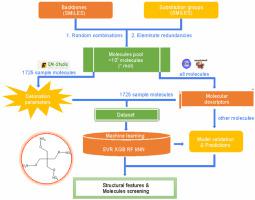Identifying the determining factors of detonation properties for linear nitroaliphatics with high-throughput computation and machine learning
IF 3.3
Q2 CHEMISTRY, MULTIDISCIPLINARY
引用次数: 0
Abstract
In this work, a high-throughput computation (HTC) and machine learning (ML) combined method was applied to identify the determining factors of the detonation velocity () and detonation pressure () of energetic molecules and screen potential high-energy molecules with acceptable stability in a high-throughput way. The HTC was performed based on 1725 sample molecules abstracted from a dataset of over 106 linear nitroaliphatics with 1- to 6-membered C backbones and three types of substituents, namely single nitro group (-NO2), nitroamine (-NNO2), and nitrate ester (-ONO2). ML models were established based on the HTC results to screen high-energy molecules and to identify the determining factors of and . Compared with quantum chemistry calculation results, the absolute relative errors of and obtained using the ML models were less than 3.63% and 5%, respectively. Furthermore, eight molecules with high energy and acceptable stability were selected as potential candidates. This study shows the high efficiency of the combination of HTC and ML in high-throughput screening.


用高通量计算和机器学习方法确定线性硝基脂肪族爆轰特性的决定因素
本研究采用高通量计算(HTC)和机器学习(ML)相结合的方法,确定高能分子的爆速(vd)和爆压(pd)的决定因素,并以高通量的方式筛选稳定性可接受的潜在高能分子。HTC是基于从106个具有1- 6元C骨架和三种取代基(单硝基(- no2)、硝胺(- nno2)和硝酸酯(- ono2)的线性硝基脂肪族数据集中提取的1725个样品分子进行的。基于HTC结果建立ML模型,筛选高能分子,确定vd和pd的决定因素。与量子化学计算结果相比,用ML模型得到的vd和pd的绝对相对误差分别小于3.63%和5%。此外,还选择了8个具有高能量和可接受稳定性的分子作为候选分子。本研究显示了HTC与ML联合进行高通量筛选的高效率。
本文章由计算机程序翻译,如有差异,请以英文原文为准。
求助全文
约1分钟内获得全文
求助全文
来源期刊

Energetic Materials Frontiers
Materials Science-Materials Science (miscellaneous)
CiteScore
6.90
自引率
0.00%
发文量
42
审稿时长
12 weeks
 求助内容:
求助内容: 应助结果提醒方式:
应助结果提醒方式:


